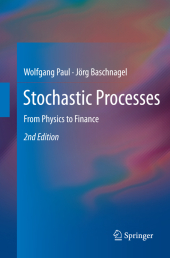 Neuerscheinungen 2015Stand: 2020-02-01 |
Schnellsuche
ISBN/Stichwort/Autor
|
Herderstra▀e 10
10625 Berlin
Tel.: 030 315 714 16
Fax 030 315 714 14
info@buchspektrum.de |

J÷rg Baschnagel, Wolfgang Paul
(Beteiligte)
Stochastic Processes
From Physics to Finance
2. Aufl. 2015. xiii, 280 S. 43 SW-Abb. 235 mm
Verlag/Jahr: SPRINGER, BERLIN; SPRINGER INTERNATIONAL PUBLISHING 2015
ISBN: 3-319-03378-6 (3319033786)
Neue ISBN: 978-3-319-03378-5 (9783319033785)
Preis und Lieferzeit: Bitte klicken
This book introduces the theory of stochastic processes with applications taken from physics and finance. Fundamental concepts like the random walk or Brownian motion but also Levy-stable distributions are discussed. Applications are selected to show the interdisciplinary character of the concepts and methods. In the second edition of the book a discussion of extreme events ranging from their mathematical definition to their importance for financial crashes was included. The exposition of basic notions of probability theory and the Brownian motion problem as well as the relation between conservative diffusion processes and quantum mechanics is expanded. The second edition also enlarges the treatment of financial markets. Beyond a presentation of geometric Brownian motion and the Black-Scholes approach to option pricing as well as the econophysics analysis of the stylized facts of financial markets, an introduction to agent based modeling approaches is given.
A First Glimpse of Stochastic Processes.- A Brief Survey of the Mathematics of Probability Theory.- Diffusion Processes.- Beyond the Central Limit Theorem: LÚvy Distributions.- Modeling the Financial Market.- Stable Distributions Revisited.- Hyperspherical Polar Coordinates.- The Weierstrass Random Walk Revisited.- The Exponentially Truncated LÚvy Flight.- Put-Call Parity.- Geometric Brownian Motion.
From the book reviews:
"The authors, both physicists, have revised their successful book first published in 2000. ... the stochastic processes are presented clearly in mathematical language, e.g., with measure theoretical formalism, which makes the book readable for mathematicians. Its value for mathematicians, especially those who are already familiar with the basic ideas of mathematical finance, is in the many examples from physics, that provide a broad overview of the basic models and ideas of statistical physics." (Peter E. Kloeden, SIAM Review, Vol. 56 (4), December, 2014)


